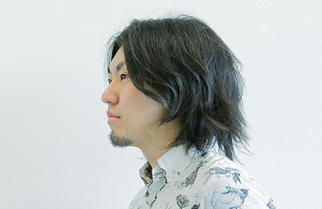
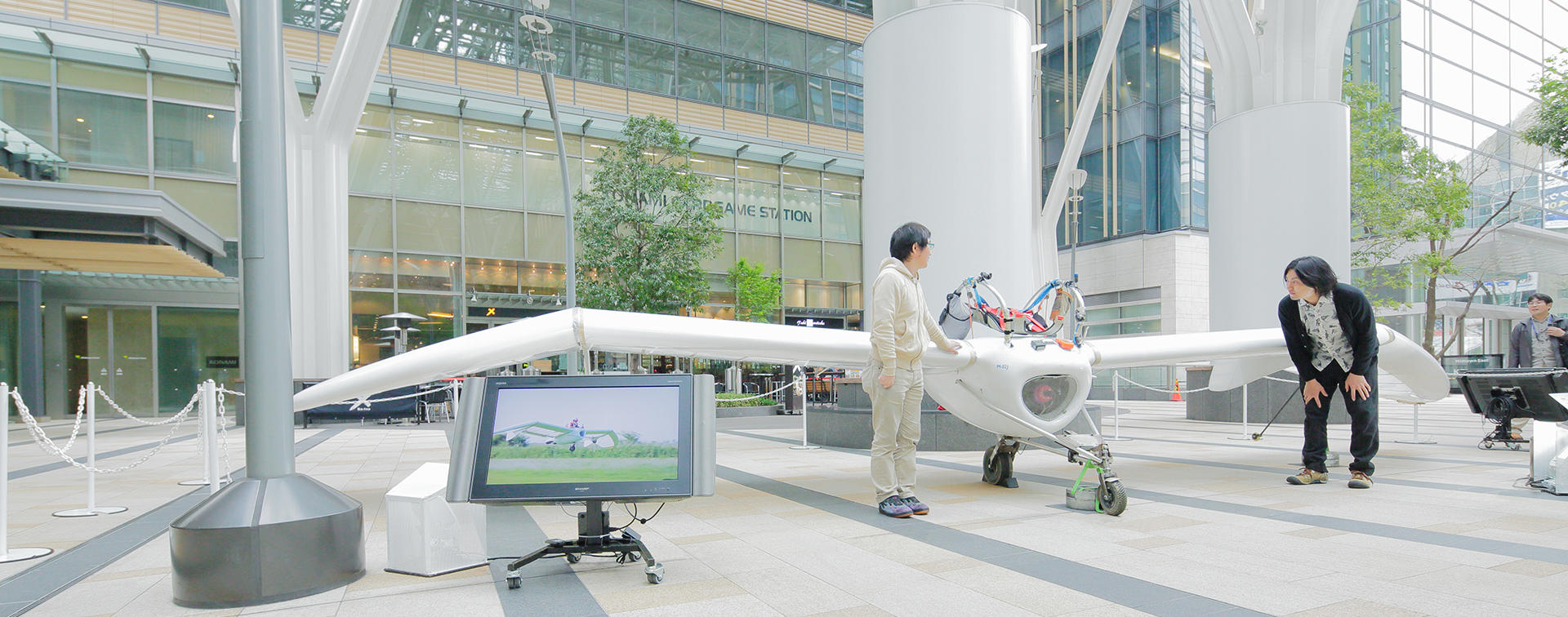
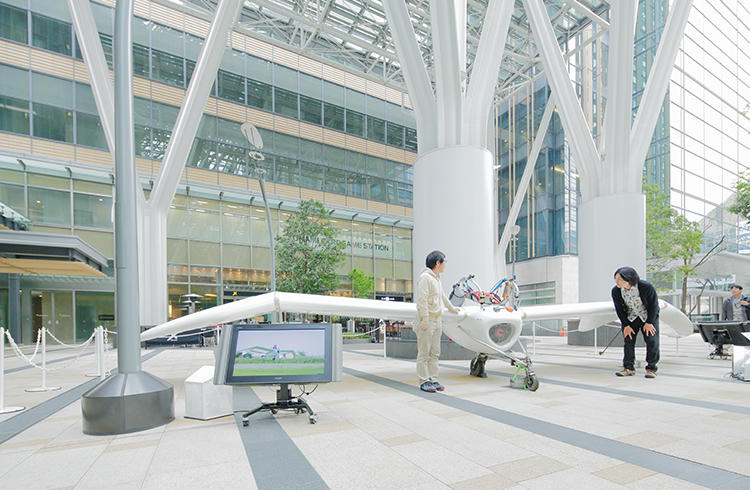
Thinking about the future of Roppongi's public spaces and art
Pedestrians paradise on Roppongi Art Night
Kazuhiko Hachiya is architect of the "OpenSky:M-02J" - a glider modeled after the aircraft Möwe depicted in the anime "Nausicaä of the Valley of the Wind" - which was displayed at "Roppongi Art Night 2014". Meanwhile, Kosei Komatsu is designer of the "Like a bird-display-Mohri Garden" - an installation placed in the bottom of a pond in Mohri Garden which creates ripples in the water and gives movements to the light patterns. At the Tokyo Midtown Award 2008, Hachiya happened to be the judge while Komatsu was an award recipient. We began the interview by asking them about their memories of the competition.
Frustrated with the Tokyo Midtown Award
Hachiya You won your award Komatsu-san, in the very first art competition of the Tokyo Midtown Award, when the direction of the event had not been fully established, and we were still pondering what kind of works would be appropriate for the award. It was difficult for the judges to make decisions, but we all agreed that we should choose works that were challenging and which were suitable for being shown in public spaces.
Komatsu It must have been the most interesting time. I entered the world of art from the world of architecture. I was looking for an opportunity to show my works, so I was regularly entering art competitions. Tokyo Midtown Award was a new competition, and (at that time), it was limited to young people. When I learned of it, I thought, I definitely must take part in this! And I was excited to think that my work might be displayed in Roppongi and viewed by a lot of people. I was extremely ambitious then. (laughs)
Hachiya In the 2008 competition, there was no winner of the Grand Prix. When the prizes were announced, did you feel that the Grand Prix ought to have been given out?
Komatsu No, I didn't feel that way. I knew that the Grand Prix at other competitions such as Taro Okamoto Award for Contemporary Art hadn't been given out for a long time. People were probably looking for a work that went beyond the given framework. What got me was that the prize I received was the Commendation Prize. There was no feeling of triumph - I just felt frustrated.
Hachiya This is something that I can tell you now, but I knew at the time that you had made better works...Maybe that was not quite the right way to look at it, but knowing of better works made in the past, I couldn't help thinking, "You can do better than this." (laughs)
Komatsu Well, I too certainly did not think of the Ever-Courting Clock as being my main, core sort of work. It was something I made from my desire to go into a slightly different direction.
Hachiya In the first year of a competition, both the judges and the applicants feel their way about. Later, the Tokyo Midtown appeared to have established its sense of direction, but it wasn't long before the exhibition venues were changed and the themes were changed. I think that's a good thing, because if it's the same each time, it will become monotonous, and people will get fixed ideas about the kind of works which will likely win prizes.
Roppongi as mini-Tokyo and Tokyo Midtown as a good student
Hachiya Incidentally, I think of Tokyo Midtown as being like a very good student. If the whole of Roppongi were an elementary school, then Tokyo Midtown would be the president of the student council. It's as if Tokyo Midtown is taking it on itself to be the daytime face of Roppongi. (laughs) With its many facets, I think Roppongi is an intriguing place.
Some parts are like Kabukicho, and some parts are like Ueno. It's like a mini version of Tokyo. The northern part of Roppongi is like Ueno, don't you think? There is the Suntory Museum of Art where you can see classical art, and there is the National Art Center, Tokyo with its peaceful atmosphere.
Komatsu Roppongi has many venues for young artists to show their works. There are also truly inspiring places such as the Mori Art Museum. And there's a sense that many opportunities exist in the area, with events like the Tokyo Midtown Award offering public spaces. At Roppongi Art Night, there are artists who do guerilla art, although I'm not sure whether their art is generally approved of or not. (laughs)
Hachiya It's difficult to describe Roppongi in a word. There is every kind of establishment here, from the cheap ones to the expensive ones. People who come from abroad appreciate the fact that there are establishments open until late at night. Of course, you can have a night out in Shibuya or Shinjuku, but the good thing about Roppongi is that it's a slightly safer place.
Komatsu There are places in Roppongi that are very well designed and stylish, while on the other hand, there are places that are messy and chaotic. All kinds of elements are to be found, and there's no leaning toward one direction. I'm not very fond of anything that is concentrated on just one main thing, so it's nice that Roppongi has a wide scope.
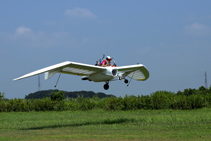
OpenSky:M-02J
A project launched in 2003 to make a personal jet glider modeled after the aircraft Möwe in the anime "Nausicaä of the Valley of the Wind." In 2013, a successful flight was made of a glider equipped with a jet engine.
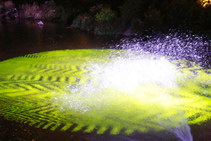
Like a bird-display-Mohri Garden
An art installation placed at the bottom of the pond at Mori Garden on the compounds of Roppongi Hills. The pond came alive with the light patterns and water sprays which expressed the display movements of a bird during a courtship ritual.

Tokyo Midtown Award
A design and art competition started in 2008 by Tokyo Midtown. Comprising of the art competition and design competition, "Japan Value" is the standard by which prizes are given to works. Kosei Komatsu's "Ever-Courting Clock" (photo) won the Commendation Prize in 2008. The work consists of 360 clocks whose hands are made from peacock feathers.
The difficulties posed by a one-night event
Hachiya As for my frank opinion on Roppongi Art Night, my feeling is "What? Why is it only for just one-night?" (laughs) My works were shown in two places this year, and since I participated in "Rokuhonmoku Yorakue", I had no time at all to enjoy other events or look at other people's works. I wasn't able to look at your work either, Komatsu-san, I'm sorry to say. As an artist taking part, I think it would be better if Roppong Art Night was at least one day longer to allow for a preview.
Rokuhonmoku Yorakue
A talk event that started in 2013 as part of the program for Roppongi Art Night. Creators and artists hold talk shows in various restaurants and establishments in Roppongi. Hachiya was among the roughly 20 people who held the talk shows this year; others artists included Michihiko Yanai, Daito Manabe, and Chie Morimoto.
Komatsu As an artist who also participated in Roppongi Art Night, I found it difficult to decide on how to show my outdoor installation. Because it's only for one night, a lot depends so much on the weather, and I wavered, wondering whether I should focus on the daytime or nighttime, and whether it's doesn't matter if it rains.
Hachiya I did that kind of thinking too and had the OpenSky:M-02J installed on the first floor of Tokyo Midtown. It was positioned in a place where there are buildings on the three sides and no wind blows in. At last year's Roppongi Art Night, I actually saw an artwork get broken by the wind. If wind came in at a speed of 10 meters per second, my glider would easily be carried away.
Komatsu Is it possible to fly the glider like a kite? I wish you could it have it flying like in the Valley of the Wind.
Hachiya It would be possible if there was constant wind blowing from one direction, like at sea.
Komatsu Oh, I would love to see that!
Hachiya Another suggestion I have for Roppongi Art Night, which would also benefit the visitors, is to create a pedestrian paradise. I don't know who, but someone said words to the effect that when people go shopping, they always walk - they never shop while in their cars. I enjoy walking in Ginza on Sundays. I think the pedestrian paradise there is wonderful. There also used to be a pedestrian paradise in Harajuku. In other places too, like Shimokitazawa, the streets are virtually closed off to automobiles. When the roads are blocked, a town becomes livelier.
Komatsu I agree with you. When walking the streets, I notice that the cars are moving at a different level of tension, and it's jarring.
Hachiya Right. In Austria, for example, at the Ars Electronica, they close off all the main roads to traffic. Everyone gathers in the streets and fireworks are set off, and there's a really festive atmosphere. It would be nice to have at a pedestrian paradise at next year's Roppongi Art Night, even if only from midnight to six in the morning.
Ars Electronica
A festival of media arts held every year in Linz, Austria. Exhibitions, performances, symposiums and competitions are held all over the city, drawing creators and visitors from around the world.

Lifelog_Glider - a project that took four years to complete
Komatsu I have an interest in flying and floating, and the works I create are themed on birds. The Lifelog_Glider is an object made from feathers which floats above a fan. It's about 90-cm tall and is considerably large for an object that keeps floating. This project didn't go well for a long time - it took me four whole years to complete it.
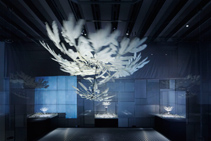
Lifelog_Glider
An installation of a feathered object which is floated by winds from a large fan. The object consists of circular bands covered with goose feathers. The work was made with support from the Agency for Cultural Affairs project to support and nurture media arts creators, and was shown at Media Ambition Tokyo 2014, a technology and art event.
Hachiya If you had submitted this [at the Tokyo Midtown Award competition], you would have won the Grand Prix! (laughs)
Komatsu I would have liked to have submitted a work a like this for competition, but keeping an object up in the air is quite a tricky task. You have to set it up to fit the venue, and things can go wrong. For instance, when the door of the exhibition room opens, the air coming in can cause the object to fall.
Hachiya I can see that it would be difficult to make something that is quite big which is also lovely to look at, and to keep it constantly floating. I'm impressed that you have finally done it and come so far.
Komatsu By making these chandelier-like works, I've gotten the hang of using feathers, and I'm now wondering how far I can go in making feathers dance. But things get difficult when my works are displayed in public spaces instead of art museums. I've done quite a lot of exhibitions in public spaces, but it's always hard work thinking about matters such as the ornamental aspects and display methods. I would love to make something bigger if I could.
Hachiya Really? You mean something as tall as 10 meters, for example?
Komatsu That would be possible.. I think. There really are no appropriate places though. Please, Roppongi-san, could you provide me with such a place? (laughs)
Prompted by the Iraq War to create Möwe
Hachiya How did you get started in making works using feathers?
Komatsu For my university graduation project, I used a huge amount of feathers as materials that would float. I stored the work away, and when summer came, I noticed an animal-like smell coming from it. It was then that I realized with a shock that feathers are part of living creatures. Feathers are so high-tech. I tried using other materials like paper to make my work float, but had no success with any of them - the only material that carried the wind was feathers.
It's so fascinating that birds have followed a path of evolution different from humans which has led to this kind of technology. That's why I admire your works, Hachiya-san. I mean, you fly! It's a dream that most of us cannot realize.
Hachiya I got the idea of making a real-life Möwe when the Iraq war erupted in 2003. When U.S. President Bush attacked Iraq and Prime Minister Koizumi immediately expressed his support, I was dumbfounded. I thought, Nausicaä wouldn't make that kind of decision. Starting this project was my way of saying that we want a leader like Nausicaä.
Komatsu Artists of a generation or two above me place importance on making works with big themes. But ever since a student, I've been wary of going with that trend. I feel that I shouldn't do the same thing that I was taught at school.
Hachiya That's a very healthy way of thinking. (laughs)
Komatsu Even if I don't make such works, other people will. (laughs) In the world of art, a new generation emerges on the scene by saying no to the generation before them. I've continued to pursue what I enjoy making even though some of my works may not have been appreciated at some art competitions, and that's how I've come to do what I do now.
Komatsu Actually, it's not my real wish to make things that have a political message or that are themed on a big phenomenon. However big an event might be, it does not stay as "news". I might give it serious thought in the beginning but after 10 years, the phenomenon inevitably loses its reality both for me and for the people looking at my work. It's a fact that the "OpenSky" project is linked to the Iraq War, but the glider also has other elements. I usually try not to create works with just one idea.
Flying - a powerfully attractive idea
Hachiya I fundamentally share the same kind of thinking as you, Komatsu-san. I feel that the other theme of Möwe is the human desire to look at things that float or the human desire to fly. Maybe this is not a very good example, but the Aum Shinrikyo claimed that at the end of their training, people would be able to float in the air, and a lot of people were drawn to the cult because of that. I think the idea of floating and defying gravity is so powerfully attractive that it can lead people to lose rationality.
Komatsu It took me four whole years to get feathers to float, but you Hachiya-san, have managed to maintain the form of your Möwe and enabled it to carry a human being. Your accomplishment awes me.
Hachiya To make something that weighs 100 tons float vertically upwards, it's necessary to have power that exceeds 100 tons. But when you use wings, you can use the power of the air, and a tenth of output is sufficient. You mentioned this too, but feathers have an elegant mechanism. Birds are descended from dinosaurs, and they gained their feathers in a path of evolution spanning tens of millions of years. I'm always gazing at birds and marveling at what amazing creatures they are.
Komatsu When a bird stops on a branch, it's a miraculous moment, isn't it? It comes at great speed and then gently perches itself. I imagine that with the Möwe, you must have had a hard time making into reality all the movements depicted in the anime.
Hachiya There are still things which I can see in my mind's eye but which cannot be made into reality for a variety of reasons. (laughs)

A public space curated like an art museum
Komatsu Oh yes, there's something I wanted to talk about today. In displaying works in public spaces, I've come to notice that the venues do not look very good when photographed. This can be said of the [venues at] Tokyo Midtown Award. Nowadays, people instantly share photos and movies, and it would be nice if there were places that enhance the appearance of an artwork, so that people would go, "Wao, fantastic!" I wish that public spaces were more photogenic, and more accommodating toward exhibitions. And it would be great if the towns could keep a proper record of the exhibited works and send out information on them.
Hachiya So you are envisioning announcements that go "Today the artwork in Roppongi is so and so."
Komatsu Yes. And it would be nice if there were curators like at art museums, and if works selected by the curators could be exhibited for free.
Hachiya So you are thinking of a public space where proper curation is carried out as in an art museum. And promotion could be made for the works for perhaps one week at a time, with announcements made to the world such as "This is a work in Roppongi, Tokyo, Japan for such-and-such a date and month." I like the idea.
Komatsu Expenses for producing the works will be paid, and videos of the works will be taken. Maybe a collection of videos could be shown on the Internet, like an online museum, or maybe they could be broadcast live every day.
Hachiya There are many independent curators now, so perhaps such curators could take monthly turns. Exhibitions inevitably reflect the curators' tastes, so it's not interesting when the same curator always does the selections.
Komatsu That's true. We don't want it to be concentrated in just one genre.
Hachiya I think people would come to visit such a space. They would see the artwork on the Internet on Monday, and then perhaps come on Thursday or Friday to take a look, and be glad that it was still on display.
Komatsu I wonder which places in Roppongi are photogenic?
Hachiya Maybe the "Shape of Mind (Ishinki)" sculpture on the underground at Tokyo Midtown could be removed... I'm only joking. But that is a very good spot to show artwork. How about returning the Ishinki to the spot in October, and for the rest of the year, have displays of different artwork every month?
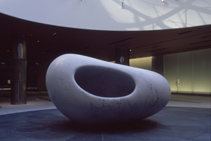
Shape of Mind (Ishinki)
A public art sculpture made from a massive slab of marble. Located on B1 of Tokyo Midtown, it is one of the main artworks of Tokyo Midtown, together with "Key to a Dream" (Myomu) also made by Kan Yasuda.
A place where control of the environment is possible
Hachiya All kinds of people come to Roppongi - people who are interested in art and those who aren't. The works you and I make are not the kind that cannot be understood without an understanding of artistic context. For artists like us, Roppongi is a very attractive place.
One thing I noticed though, when showing my work at Roppongi Art Night, is that it needs to be shown with footage of the glider flying because otherwise, visitors cannot be convinced that it can actually fly. In contrast, your work is constantly floating, so I envy you, Komatsu-san !
Komatsu But I also face many problems in making things go well. For example, if I try to make something for the lawn in Tokyo Midtown, there are lots of obstacles such as the rain or a strong wind and so on. I wish there was a place like the Grand Palais in Paris which is covered with glass and where the environment and weather conditions can be kept under control.
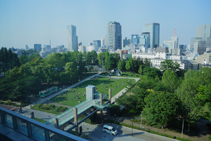
Lawn of Midtown Garden
A large expanse of green grass on the eastern side of Tokyo Midtown, adjacent to Hinokicho Park, the park belonging to Minato ward. Several different types of grass are grown to keep the lawn green. The lawn is opened to the public as a resting place and is often used for events.
Grand Palais
A building constructed in 1900 for the Universal Exposition. 240 meters long, and 45 meters high, it is characterized by its glass ceilings. Currently a national art museum, it is used for special exhibitions and events such as fashion shows.
Hachiya So it wouldn't matter even if clouds suddenly appear, and there's rain or snow.
Komatsu Perhaps if there was such a space, artists will be able to do dream projects which would not be feasible elsewhere. I also have one last impossible wish.
Hachiya You want a room custom-made for your work.
Komatsu An ordinary room may not have a high enough ceiling, so I would love to have space that is both indoors and outdoors at the same time - a place that would satisfy the human egoistic desire to do something outdoors while not being affected by rain or wind. Another wish I have is to see a floating signboard - the kind often depicted in animes. Floating signboards are still part of science fiction, but I have a feeling that it's about time they became real. (laughs)
Hachiya In the summer of 2012, there was an event at the Midtown Garden featuring water fireworks with laser lights and man-made mist. I have yet to see a signboard floating in the air though.
Komatsu It's nice that there is nothing on the lawn here. I suppose that's why people get the urge to do things on it. Walking though the dazzling streets of Roppongi is fun, but when walking from Roppongi Hills to Tokyo Midtown, I am brought back to reality. I look up and see a very realistic landscape - I realize that I am still in a city on earth. (laughs)
Hachiya You realize that you're not in space, and not in the future. And that you are also tied down by gravity.
Komatsu But I also feel that Roppongi will allow me to be reckless. Actually, I'm more concerned about my own future than the future of Roppongi...
Editor's thoughts
After the interview, Hachiya-san remarked that one needs to be prepared to be hated when working as a judge at a competition. To this remark, Komatsu-san said that he used to hold a grudge against a lot of people. "Does that mean you had a grudge against me too?" asked Hachiya-san. "No, Hachiya-san. You helped me," was the reply. Komatsu-san obviously felt at ease talking frankly with his understanding mentor, and the atmosphere of trust made for a pleasant interview.(edit_kentaro inoue)





